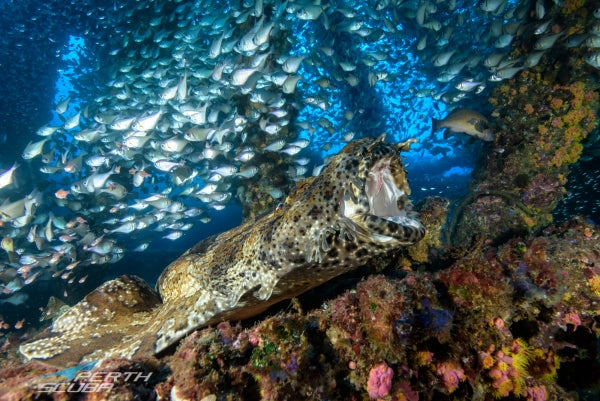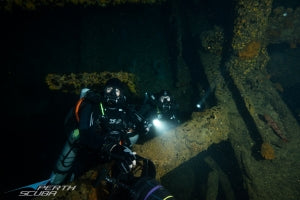Diving the wreck of the Key Biscayne
Diving the wreck of the Key Biscayne
Lancelin, Western Australia
The date is Friday the 1st of September 1983. Rough seas and an 8 metre swell off the coast of Lancelin and 100km/h winds are buffeting the Key Biscayne, a jack up oil rig, which is being towed by two offshore supply vessels, the Lady Sonia and the Atlas Van Dieman, bound for Fremantle for maintenance. The seas are relentless and unforgiving amd at 6:44am the towline from the Lady Sonia breaks causing the rig to flounder in open seas with only one towline connected.

Attempts to pass a new towline are unsuccessful. During this time the rig has settled by the stern and develops a starboard list. As seas begin breaking over the deck it is decided that all 52 crew should be evacuated. At 4.20pm the last helicopter leaves the rig and heads for the safety of Lancelin. As night falls the Key Biscayne, being battered by huge seas finally breaks its last towline, that of the Atlas van Dieman.
The Key Biscayne is now left in a state of no directional control and is rolling with the heavy seas and swell. Seawater rushing over the deck begins to fill the aft section through the shale shaker return line and soon floods the mud pits and pump room. Soon, other compartments fill with water and asshe sinks lower into the ocean, more water rushes in causing instability and sealing the fate of the Key Biscayne.The rig rolls to the starboard side and capsizes. Within minutes, she makes her last roll and heads to the bottom of the dark clear waters 11 nautical miles off the Lancelin coast in 42 metres of water. The impact of the rig in her final resting place sheers the steel legs from their fixings and sends them to the ocean floor beside the rig which is now upside down. As the night sets in, the lights have faded to darkness on the horizon. The Key Biscayne has gone…

Almost 37 years later and Blue Destiny with 27 divers onboard are sitting above the Key Biscayne wreck for the annual March Public Holiday Lancelin dive trip. The flat calm conditions are a total contrast to those on that fateful night back in 1983 and are ideal for the planned dives ahead.
This dive attracts all types of divers from Technical twin tank, Trimix and rebreather divers, to side mount divers and curious recreational single tank Nitrox divers. Whether this is your first dive on the Key Biscayne or your 80th as Perth Scuba’s Tech Instructor Joseph Bicanic was about to embark on, the Key Biscayne is a dive that offers so much for everyone. For Photographers, this is a mecca of sharks, rays, fish, cuttlefish and critters.
For the hunter, Crayfish are everywhere and for the explorer, the wreck is positioned so that you can get right inside the wreck to go down corridors and into rooms which join on to more rooms and corridors. For the serious wreck diver, there is no reason to see daylight through the entire dive.
Descending onto the wreck is a great site as the wreck starts to come into focus. Only when you see the legs along side the wreck, do you actually realise how big this wreck is and the realisation that even after 80 dives, you are unlikely to have even touched the surface of the secrets the Key Biscayne holds as a dive wreck.

Our very own pro photograph guru and rebreather diver Joey Pool got some amazing photographs proving that rebreathers are definitely the way to get up close and personal with critters. Her shot of the trip had to be the “Angry Wobbegong” who was telling her off for taking her photograph. Some fantastic photographs of Grey Nurse Sharks cruising up and down the legs of the wreck and some very cute Port Jackson Shark images are just a few of what turned out to be a great long weekend of diving.
Lots of very happy divers with lots of great stories to tell, showing once again that the events of that fateful evening in September, 37 years ago are still remembered as we celebrate the resulting dive wreck of the oil rig the Key Biscayne.



